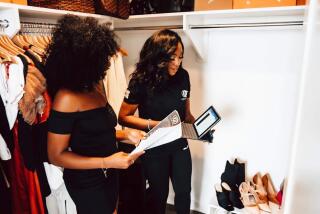A Friendlier Climate for Women
- Share via
Q: Why are female business owners less likely than men to obtain financing, even though women-owned businesses are the fastest-growing segment of the business economy?
A: There are so many reasons, and there is no single, obvious answer. My sense is that female business owners own service-type businesses, such as advertising, marketing and public relations companies that don’t require a lot to set up. So their need for loans is less critical and less a normal part of their business. I think women also are concerned about receiving credit, and they’re less familiar with the process of obtaining a loan.
Q: Do you believe women have been discriminated against in the banking world?
A: I don’t think anyone would say discrimination is consciously going on. But what’s important is that women should not perceive that any discrimination is taking place. You would never want anyone not to seek credit if they need it.
I think women’s attitudes toward banking have changed dramatically in recent years. A study we conducted with the National Foundation of Women Business Owners in the fall of 1996 showed that there is no difference between how women and men perceive banking.
The study also showed that women use credit more for expansion, while men use it to pay off debts. There were many differences between the results of that study and a 1994 study. The biggest difference is that women don’t rely as much on credit cards to finance their companies, which is a marvelous change.
Q: Aside from securing financing, what are some of the biggest obstacles facing female entrepreneurs today, and what can be done to eliminate those barriers?
A: Women face the same barriers as all small-business owners. There is a lot of frustration with government regulations on hiring employees and all the paperwork that entails. And I think people who have young businesses have difficulty juggling all their responsibilities. Managing a business is an enormous challenge, whether it’s hiring people or keeping track of the books.
I would recommend that people join business organizations and support groups, or take classes at community colleges to learn more about business with others. All of the community colleges have good programs. The Small Business Administration, the Chamber of Commerce and various associations also can help.
The loneliness of being a business owner sometimes can be the biggest challenge. But I’ve found that women are very good at networking and asking attorneys or other small-business people for advice. I think it’s very positive that women are quite open to doing that.
Q: In what areas do you see the most potential for female business owners?
A: The fastest-growing areas are nontraditional industries, such as manufacturing, auto repair, things like that. That’s where there is opportunity. The biggest growth areas are related to high-tech services, such as computer repair, networking, technology training. I’m seeing a lot of women getting involved in technical areas. What I’ve seen is that women who have technical skills do well because they are very good at working with people. Importing and exporting is another growing area, particularly on the West Coast. What’s attractive about import-export is that it’s growing, and when an industry is growing, it’s easier to enter a business and not displace anyone.
Q: How is today’s generation of female business owners different than previous generations?
A: For one thing, today’s generation of female business owners are a generation younger than women with established business who are in their 40s and 50s. I think it’s far more acceptable for women to enter business now than it was 20 years ago, so less groundbreaking is necessary. There’s more of a “Why not?” attitude than an attitude of “Gee, I’m going to go out and do this.”
There seems to be greater freedom of self-determination rather than just gritty determination. Right now, 36% of all small businesses in this country, and 39% of those in California, are owned by women. Because of this, I think there’s a much greater acceptance among the public of purchasing something from a woman.
Historically, women have started small businesses after they gain some experience. It’s something they do in their 40s. But now, we’re seeing 18-year-old women starting companies. I think we’re seeing a lot more young female entrepreneurs because of all the opportunities out there.
*
Q: Why are more women starting their own businesses?
A: There are lots of reasons. Some technology trends are making it easier to start a business. Now, with a personal computer, a modem, an answering machine, a beeper and a mobile phone, you can leverage a one- or two-person business and make a real go at it. Technology has made entry into business easier.
Family-related situations also have prompted many women to start their own businesses. When you have your own business, you typically work 60 or 70 hours a week, so you don’t start a small business to work less. But women are doing it because they can be their own boss. If they want to take time off in the middle of the day, they can do it. They can take time off to visit their children’s teachers because they are their own boss. A lot of people will work from 9 to 3, feed the kids, put them to bed and then work from 8 to midnight.
Another trend we’ve noticed is that a substantial number of our customers have home-based businesses, and again, technology is making this possible.
*
Q: Do you see differences between female entrepreneurs on the West Coast and in other parts of the country?
A: Yes. For one thing, women on the West Coast are more likely to set up their own businesses than women on the East Coast. I think this is because people who want to try new things tend to move west. There also is more growth on the West Coast in nontraditional areas of business, which I mentioned before and include such things as auto salvage, computer networking and video businesses. Traditional businesses are involved in retailing and servicing, while nontraditional businesses are involved in manufacturing, agriculture and other technical areas.
*
Q: Why did Wells Fargo decide to initiate a special loan program for women? Were women not served well by existing loan programs?
A We received information from the National Foundation for Women Business Owners that women felt unhappy about their relationships with banks and perceived that banks were less open to women. Because of our lending process, we knew we treated women equitably. But we still saw having a special program as a good business opportunity.
*
Q: What expectations did Wells Fargo have when it initiated the program? Have the results exceeded these expectations?
A: We expected to lend $1 billion in two or three years, but we exceeded that by lending the first billion at the end of 12 months. We then committed to lending $10 billion over 10 years.
The response to the program was a wonderful surprise. We have marvelous stories about women who were turned down by local banks and came to us want-ing alternatives. The reason women like our program is it’s simple to get credit. We don’t require tax returns or financial statements, and women don’t have to renew annually.
*
Q: How many female entrepreneurs have taken advantage of the loan program since it began in 1995? And do you expect the program to grow even further?
A: There are about 75,000 women nationwide. The program is very large and very representative demographically of women across the country. ... We have no reason to believe it won’t continue to grow. We now have many competitors. Since we began, many other banks have started similar programs.
*
Q: Are most of your loans backed by the Small Business Administration?
A: A relatively small percentage of our loans are SBA-backed because we offer programs to people with established businesses of at least two years. We only loan to women with a good personal and business credit record.
*
Q: Since women need to be in business for two years before they qualify for Wells Fargo’s loan program, what can women just starting out do to finance their businesses?
A: For most people, it takes about $5,000 to start a business. Typically, you can start a business with your own savings, loans from family members, or you can find investors among friends. The SBA can also help. Credit cards can be useful, but don’t overdo it, because it can make it harder for you later. It’s good to get checking and business savings accounts. You should also get at least two business credit lines, and you should look into leasing equipment at first.
More to Read
Inside the business of entertainment
The Wide Shot brings you news, analysis and insights on everything from streaming wars to production — and what it all means for the future.
You may occasionally receive promotional content from the Los Angeles Times.










